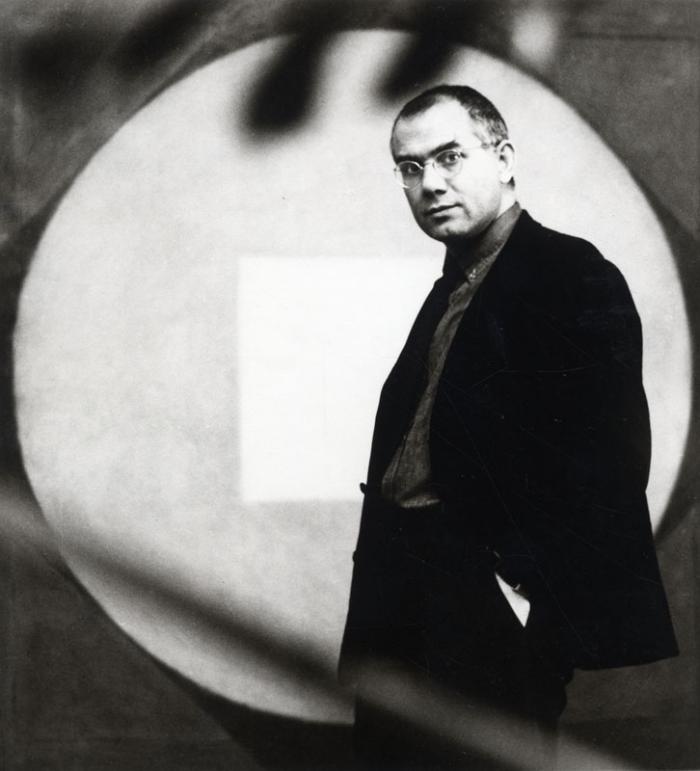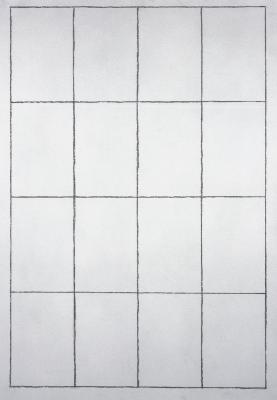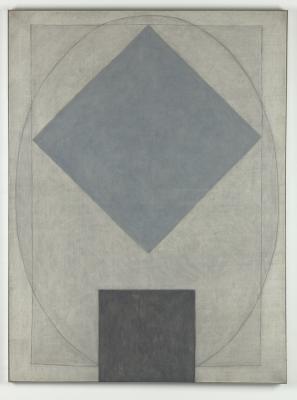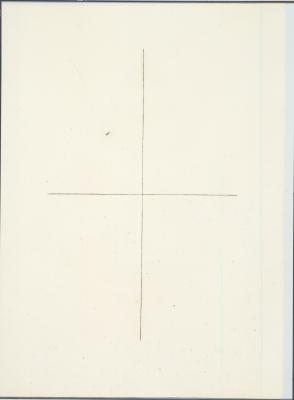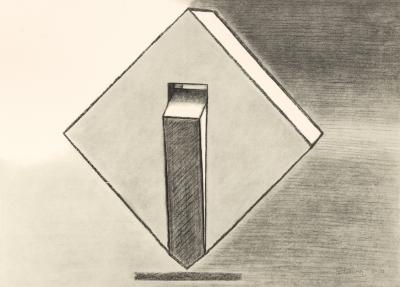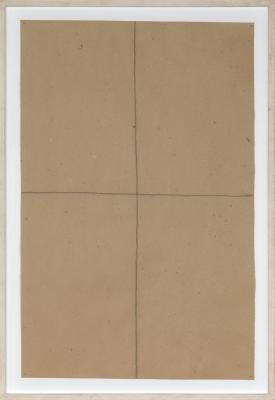One describes the abstract oeuvre of Dan Van Severen with terms such as geometric abstraction, Formalism or Minimalism. His spiritual, meditative, neo-sacred fervour is distinctive. Complex with regards to context (an ultimate reality, a transcendental truth) originates from a reduction of form. Van Severen retains only the essential. With this, he makes a radical distinction between form and content. His works have a certain distance by which he breaks every relationship with the viewer and himself. Simple geometric forms (rectangle, square, rhombus, circle and oval) determine his compositions. The works completely stand on their own with their interplay of lines and colours referring to each other, or the relationships between paper and ink and foreground and background. The viewer finds no point of entry and no approach to the artwork. The expectation of content is not fulfilled and the projected desires are obstructed. Each work refers to the previous, which indeed ensures that the oeuvre achieves a large coherence. Thus is Van Severen’s later production recognised by the sober cross-shaped compositions, which are the result of a life-long investigation into the square and rectangle.
After his studies at the Sint-Lucasinstituut in Ghent (1941 - 1948) and the Academy of Antwerp (1951), in 1957 he creates his first work from a more fundamentalist inclination. In that same year he takes part in the Jonge Belgische Schilderkunst (1956). The following year he becomes a co-founder of G58. In 1959 he begins to teach at the HRITO (Bruges). Later he teaches at the Sint-Lucasinstituut in Ghent. In 1961, Van Severen takes part in the fourth group exhibition of G58. His oeuvre evolves through the 1950’s and 60’s from expression to essence: from lyrical assays of colour within a restricted art of painting to a nearly colourless execution of lines after 1969. He participates in the Biennale of São Paulo (1967), Documenta IV (Kassel, 1968) and the Venice Biennale (1970). In 1974, for the first time an overview exhibition is dedicated to him in the Palace of Fine Arts (Brussels), which is the first in a series of many that shall follow in Ghent, Eindhoven, Amsterdam, Antwerp and Ostend. His tempera works are shown for the first time in 1978 in Galerij Dobbelhoef in Kessel, and in 1980 an overview exhibition of his graphic work is hung in the Galerij S65 in Aalst. The first Liège contacts arise, which shall later result in a two-fold architectural collaboration with the architect Bruno Albert (1941). In the beginning of the 1980’s, Van Severen creates the series Alfabet/Alphabet in which he synthesises five drawings (cross, rhombus, circle and diagonals) into a single collective drawing. In 1981, the series Kruisweg/Stations of the Cross comes about, through which he systematically adds a straight line to the cross of the first drawing. In 1984 he repeats this compositional procedure in metal. The artist is lauded with the Triennial Culture Prize for Visual Arts of Ghent (1984). A new Alfabet series comes about in 1995 (ink on canvas on panel).
1927
Dan Van Severen is born in Lokeren.
1941 - 1948
He studies at the Hoger Sint-Lucasinstituut in Ghent with Gerard Hermans, among others.
He gets to know the work of Paul Cézanne (1839 - 1906), Angelico (fra) (1387 - 1455), Piero della Francesca (1410/1420 - 1492) and the Flemish Expressionist Albert Servaes (1883 - 1966). Van Severen befriends Luc Claus, with whom he shall exhibit various times later.
1951
Begins his stay in Antwerp (until 1959). After a preparatory year under Antoon Marstboom (1905 - 1960), he studies under Julien Creytens (1897 - 1972) at the Academy of Antwerp (until 1954).
1955
Starts artistic career and participates for the first time in the group exhibition in Antwerp with classmates Ad Molendijk (1929) and Wybrand Ganzevoort (1930).
1957
On the advice of Marc Callewaert and Antoon Marstboom, Van Severen takes part in Jonge Belgische Schilderkunst.
Frequent contacts with the writers Hugues C. Pernath (1931 - 1975), Paul Snoek (1933 - 1981) and Ivo Michiels (1923 - 2012).
1958
Founding member of the G58-Hessenhuis.
1959
Moves to Bruges, where he lives until 1971. Becomes a teacher at the HRITO (Hoger Rijksinstituut voor Technisch Onderwijs).
Comes into contact with the group Raaklijn.
1961
The artist participates in the fourth group exhibition of G58.
1964
Regular contacts with Roger Raveel (1921 - 2013), Hugo Claus (1929 - 2008) and Hugues C. Pernath.
1966
The Museum of Fine Arts in Ghent purchases two drawings by the artist.
1967
Takes part in the Biennale of São Paulo with Vic Gentils, Félix Roulin (1931), Serge Vandercam and Jef Verheyen.
An issue of the publication Het 5de Wiel is dedicated to Van Severen.
1968
Participates in Documenta IV in Kassel.
1969
Makes his last oil painting, Blue Composition, which is taken up by the collection of the SMAK in Ghent.
1970
Participates in the 35th Biennale of Venice, along with Bram Bogaert, Georges Collignon, Jean-Paul Laenen, Walter Leblanc and Jef Verheyen.
1971
Dan Van Severen moves to Ghent and becomes a teacher of painting at the Hoger Sint-Lucasinstituut.
1972
At the Documenta of Kassel, he is seriously intrigued by the work of Brice Marden (1938), Robert Ryman (1930) and Richard Serra (1939).
1974
The first overview exhibition is organised in the Palace of Fine Arts in Brussels.
1975
The artist makes a painting with tempera for the first time on canvas.
1976
The first drawings on Indian paper come about.
The theme of the ‘lattice’ becomes more and more prominent and culminates in De kruisweg/The Stations of the Cross in 1981.
1978
First exhibition of works on tempera canvas in Galerij Dobbelhoef, Kessel. Overview of the graphic work in Galerij S65 (Aalst) on the occasion of the publication of the folio with the poems of Hugo Claus: Antiphon, bij 4 etsen van Dan Van Severen/Antiphon, with 4 sketches by Dan Van Severen.
1980
With the exhibition Dan Van Severen. Recente werken, schilderijen—tekeningen—etsen—werktekeningen. 1955-79 in the Richard Foncke Gallery in Ghent, the first contacts are made with the Liège circle of friends.
1981
Van Severen regularly refers to the The Stations of the Cross by Henri Matisse (1869-1954) and that of Barnett Newman (1958). At the exhibition in the Richard Foncke Gallery he exhibits the Kruisweg/Stations of the Cross.
It consists of a series of 14 drawings (Chinese ink on Indian paper) and a sketch, which is followed up by an iron sculpture in 1985.
With Alfabet/Alphabet, a series of 6 drawings on Indian paper, various motifs are indicated. The same theme repeatedly comes back in the following years.
1982
Retrospective exhibition in Ghent, Eindhoven and Amsterdam. Publication of Dan Van Severen by Leo Van Damme (Foncke Editions).
1984
Receives the Triennial Culture Prize for Visual Arts of the City of Ghent.
1985
Exhibition of the metal Kruisweg (Stations of the Cross) and presentation of the publication Dan Van Severen. Etsen in the Richard Foncke Gallery.
From April 1985 until June 1986 he stays in Liège (Outremeuse), where he collaborates with architect Bruno Albert and engineer René Greisch (1929 - 2000) for the Mardaga publishing house. It is the first time that Van Severen accepts a project for the integration of a work into a building. He is involved in the design project from the beginning, which is for him indeed essential in order to arrive at a successful result. The collaboration with Albert is continued during other projects.
He participates in Investigations in Liège, where he creates a sculpture and a drawing in situ.
1986
Returns to Ghent.
1989
First solo exhibition in Japan in the Shimada Yamahushi gallery.
Presentation of two private collections with work by Van Severen in Atelier 340 in Brussels and Een Kollektie in Galerij XXI in Antwerp.
1992
Overview exhibition in Museum Dhondt-Dhaenens (Deurle) on the occasion of his 65th birthday.
The exhibition in Galerij S65 contains, among other works, five works on canvas in which he takes up the motif of the alphabet again.
1993
First presentation of the dubbele tekeningen in Galerie Conrads in Düsseldorf. They refer to the drawings in the Boek, which he had began work on in 1986.
1995
The available oeuvre of Van Severen is purchased by the Groeninge Museum of Bruges. His work (paintings and graphic ensemble) receives a permanent position within the museum.
1997
Beginning of the second collaboration with architect Bruno Albert for the project Codic, Place Saint-Lambert (Liège). The Place Saint-Lambert is being renovated. Van Severen ensures for the delineation of the terraces.
He designs the logo for the new series Haute Pierre of Les Editions La Pierre d’Alun (Brussels).
1998
Retrospective exhibition in the Provincial Museum of Modern Art of Ostend. The emphasis lies upon the works on canvas after 1970 from private collections. For the first time, a significant number of panels are shown that frequently form the precursor to, or the variation of, works on a larger format, and that previously were scarcely or never exhibited before.
Beginning in March 1998, the collective drawing of the Alfabet/Alphabet is used as a frame for the publication of the Orde der Geneesheren (Association of physicians).
2000
Premier exhibition of the new Richard Foncke Gallery.
On the occasion of Interieur Kortrijk, an exhibition is organised in the seat of the BBL Kortrijk with Van Severen’s work and that of his sons Maarten (1956 - 2005) and Fabiaan (1957).
2000 - 2009
At the end of his life the artist evolves towards the figurative.
Dan Van Severen dies on 12 February 2009 in Ghent.
Sergio Servellón
CC-BY-NC (Creative Commons 4.0)
